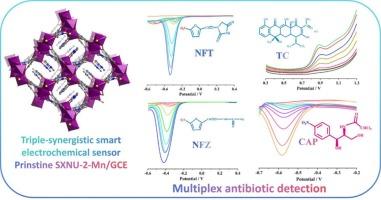Triple-synergistic Mn-MOF electrochemical sensor for multiplex antibiotic detection: A robust and stable platform for food safety monitoring
IF 4.9
Q1 CHEMISTRY, ANALYTICAL
引用次数: 0
Abstract
The excessive use of nitrofurantoin (NFT), nitrofurazone (NFZ), tetracycline hydrochloride (TC), and chloramphenicol (CAP) poses significant health risks due to their toxicity. Existing detection methods are limited in sensitivity and portability, which hinders rapid on-site monitoring of antibiotic residues contemporary livestock production. This study introduces an electrochemical sensor based on {[Mn2(BPTC)(DMA)2(H2O)2]·DMA}n (SXNU-2-Mn) (H4BPTC = biphenyl-3,3′,5,5′-tetracarboxylic acid, DMA = N, N-Dimethylacetamide, SXNU = Shanxi Normal University). The Metal-organic frameworks (MOFs) SXNU-2-Mn features a three-dimensional PtS topology with a unique pore microenvironment containing hydroxyl oxygen groups and DMA molecules, along with its manganese (Mn) catalytic center. The rod-shaped nanometer array of pristine SXNU-2-Mn/GCE sensor demonstrates exceptional performance in detecting and differentiating multiple antibiotics, including NFT, NFZ, TC, and CAP, each with distinct redox potential. Notably, for CAP, the sensor exhibits an extensive linear range from 0.07 to 900.00 μM and an exceptionally much lower limit of detection (LOD) of 19.45 nM. Stability assessments indicate that the sensor retains over 94.6 % of its initial performance after seven days, with a variation of less than 2.4 % for CAP detection. The pore environment facilitates a triple-synergistic smart recognition mechanism for CAP, involving π-π stacking, hydrogen bonding, and Mn(II)-mediated catalytic interactions. The practical applicability of the SXNU-2-Mn/GCE sensor was validated through real-world food samples such as chicken and milk, achieving recovery rates ranging from 95.45 % to 108.10 %. This research presents a pristine MOF platform that integrates molecular recognition and redox catalysis, offering a portable solution for simultaneous antibiotic residue detection and advancing food safety monitoring technologies.

用于多种抗生素检测的三协同Mn-MOF电化学传感器:一个鲁棒稳定的食品安全监测平台
呋喃妥因(NFT)、呋喃酮(NFZ)、盐酸四环素(TC)和氯霉素(CAP)的过量使用因其毒性而构成重大健康风险。现有的检测方法在灵敏性和便携性方面存在局限性,阻碍了对当代畜牧生产中抗生素残留的快速现场监测。本研究介绍了一种基于{[Mn2(BPTC)(DMA)2(H2O)2]·DMA}n (SXNU-2- mn)的电化学传感器(H4BPTC =联苯-3,3 ',5,5 ' -四羧酸,DMA = n, n -二甲基乙酰胺,SXNU =山西师范大学)。金属有机框架(mof) SXNU-2-Mn具有三维PtS拓扑结构,具有独特的孔隙微环境,含有羟基氧基团和DMA分子,以及锰(Mn)催化中心。原始SXNU-2-Mn/GCE传感器的棒状纳米阵列在检测和区分多种抗生素方面表现出卓越的性能,包括NFT, NFZ, TC和CAP,每种抗生素都具有不同的氧化还原电位。值得注意的是,对于CAP,该传感器具有0.07至900.00 μM的广泛线性范围,并且检测限(LOD)非常低,为19.45 nM。稳定性评估表明,传感器在7天后保持了超过94.6%的初始性能,CAP检测的变化小于2.4%。孔隙环境促进了CAP的三协同智能识别机制,包括π-π堆叠、氢键和Mn(II)介导的催化相互作用。通过鸡肉和牛奶等实际食品样品验证了SXNU-2-Mn/GCE传感器的实用性,回收率为95.45% ~ 108.10%。本研究提出了一个集分子识别和氧化还原催化于一体的原始MOF平台,为同时检测抗生素残留提供了便携式解决方案,推动了食品安全监测技术的发展。
本文章由计算机程序翻译,如有差异,请以英文原文为准。
求助全文
约1分钟内获得全文
求助全文
来源期刊

Sensing and Bio-Sensing Research
Engineering-Electrical and Electronic Engineering
CiteScore
10.70
自引率
3.80%
发文量
68
审稿时长
87 days
期刊介绍:
Sensing and Bio-Sensing Research is an open access journal dedicated to the research, design, development, and application of bio-sensing and sensing technologies. The editors will accept research papers, reviews, field trials, and validation studies that are of significant relevance. These submissions should describe new concepts, enhance understanding of the field, or offer insights into the practical application, manufacturing, and commercialization of bio-sensing and sensing technologies.
The journal covers a wide range of topics, including sensing principles and mechanisms, new materials development for transducers and recognition components, fabrication technology, and various types of sensors such as optical, electrochemical, mass-sensitive, gas, biosensors, and more. It also includes environmental, process control, and biomedical applications, signal processing, chemometrics, optoelectronic, mechanical, thermal, and magnetic sensors, as well as interface electronics. Additionally, it covers sensor systems and applications, µTAS (Micro Total Analysis Systems), development of solid-state devices for transducing physical signals, and analytical devices incorporating biological materials.
 求助内容:
求助内容: 应助结果提醒方式:
应助结果提醒方式:


